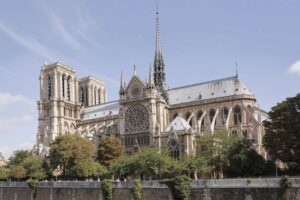Introduction: A Pavilion with Purpose
The Albania Pavilion, with its provocative topic, Building Architecture Culture, is the main attraction of the 2025 Venice Architecture Biennale. This is more than just an exhibition; it’s a conversation between the past and present, a link between the wounds of the past and the hopes of the future.
The pavilion, which was commissioned by Blendi Gonxhja, Minister of Economy, Culture, and Innovation, and curated by Anneke Abhelakh, encourages guests to rethink Albania via the country’s built environment. From historical video to futuristic graphics, every element aims to address the main query: How can building represent a country’s spirit?
Albania’s Public Areas: Historical Layers
Through its public areas, the Albania Pavilion begins by addressing the country’s complicated past. These are living palimpsests that have been altered by changing political and cultural tides; they are not static locations.
Square of Skanderbeg
Skanderbeg Square, which was formerly a huge platform for authoritarian parades, was historically weighed down by strict urban planning and nationalistic emblems. Using stone from each region of Albania to represent unification, the Belgian company 51N4E converted it into a pedestrian-first municipal centre between 2008 and 2019. By removing political power, this renovation transformed the area into a centre for daily life, community activities, and cultural gatherings.
The Tirana Pyramid
The Pyramid of Tirana, which was once constructed in honour of communist leader Enver Hoxha, has had a remarkable rebirth and is equally symbolic. Architects have redesigned it as a youth and technology centre, keeping its brutalist exterior intact, where the future generation can work together, create, and interact with cultures around the world. This change is a recovery of meaning, transforming a remnant of oppression into a ray of hope. It goes beyond simple adaptive reuse.
© Andrea Avezzů
The Current Story: The Albanian Requests
The Albanian Calls, a film essay co-created by Anneke Abhelakh and filmmaker Konstanty Konopinski, is the focal point of the pavilion. It’s an architectural dialogue that spans time and space rather than a simple documentary.
The film analyses how professional practice interacts with public policy, private commissions, and cultural identity through close-up Zoom interviews with more than 30 architects. It paints a multi-layered picture of a profession struggling with its social responsibilities by fusing it with archival video.
In order to ensure that the discussion is heard around the world, the production is not limited to the walls of Venice; it is complemented by a number of public lectures and podcasts (produced in association with KOOZARCH).

Looking Ahead: 56 Prospects for Albania
The last act of the pavilion provides a glimpse of Albania’s potential. Visitors can examine speculative concepts from 56 local and international architectural firms using stereoscopic viewers; each firm offers daring, creative solutions to Albania’s changing needs.
Notable names are on the roster:
- With poetic minimalism, Álvaro Siza
- Playful urban interventions are being brought by BIG.
- Herzog & de Meuron’s fusion of modern elegance
- Sustainable density is what MVRDV
- The architectural typologies that OODA challenges
From ecological urbanism to coastal revitalisation initiatives, these ideas prioritise cultural rootedness, sustainability, and adaptability. In many, the focus is on human-centered areas that improve everyday life rather than imposing monuments.
Image Marina Rodrigues / OODA
The Significance of This Pavilion
More than just a display, the Albania Pavilion uses architecture to tell a story about the country.
An Account of Change
Albania’s urban development reflects its political transition from dictatorship to democracy. A more inclusive and participatory view of society is reflected in the public access to areas that were formerly dominated by power.
Cultural Diplomacy through Architecture
Minister Blendi Gonxhja highlights the function of architecture as a bridge connecting the natural world, societal memory, and personal identity. The pavilion stays firmly grounded in Albanian reality while utilising this foundation to participate in international architectural discourse.
Engagement Outside of Venice
The utilisation of podcasts, film essays, and digital platforms ensures that Albania’s architectural discussion isn’t limited to privileged circles. It enables both experts and average individuals to focus on how the environments they inhabit shape their sense of belonging.
image Andrea Avezzú with Courtesy of La Biennale di Venezia
The broader context of the Biennale
The Venice Architecture Biennale in 2025 offers an appropriate setting for Albania’s narrative. With its overarching theme of “Architectures of Care,” this year’s Biennale invites countries to showcase how architecture can tackle social injustices, ecological issues, and cultural resilience.
The Albania Pavilion is notable in this regard since it confronts history head-on and reimagines the future with hope. Instead of avoiding scars, it uses them as a springboard for growth and development.

Concluding Remarks: Creating Culture, Creating Architecture
In the Albania Pavilion, architecture is both text and illustration, memory and possibility. It is like flipping through the pages of a living book. Every feature, from the Pyramid of Tirana’s renewed vitality to Skanderbeg Square’s unrestricted openness, supports the fundamental idea that architecture influences identity just as much as identity influences architecture.
The pavilion invites guests to consider questions such as: What stories do our structures tell? In addition to aesthetics. They invite what futures?
These solutions for Albania are found in architecture that respects its history, gives its citizens more control now, and creates for future generations.
Plan Your Visit
Constructing Cultural Architecture — Albania Pavilion Arsenale, Venice
10 May–23 November 2025
For more content like this CLICK HERE
References








